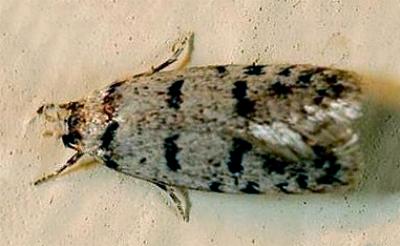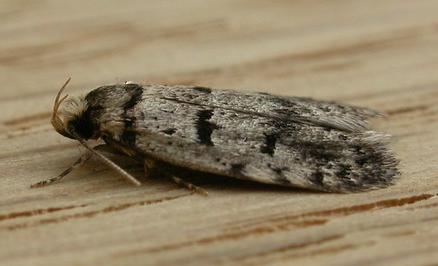
| (previously known as Eulechria episema) CHEZALA GOUP OECOPHORINAE, OECOPHORIDAE, GELECHIOIDEA | (donherbisonevans@yahoo.com) and Stella Crossley |

(Photo: courtesy of Brian Cartwright,
Adelaide Hills, South Australia)

| (previously known as Eulechria episema) CHEZALA GOUP OECOPHORINAE, OECOPHORIDAE, GELECHIOIDEA | (donherbisonevans@yahoo.com) and Stella Crossley |

(Photo: courtesy of Brian Cartwright,
Adelaide Hills, South Australia)
The Caterpillar of this species has been found feeding on the dung of
The caterpillar spends its whole time feeding inside a single scat. The caterpillar pupates in its scat.

The adult moths have pale grey-brown forewings, each some dark markings, including a narrow broken black band near the base, and two others further along the wing, and four prominent black spots on the costa. The hindwings are plain grey, fading toward the bases. The wingspan is about 2 cms.
The species has been found in
Further reading :
Ian F.B. Common,
Oecophorine Genera of Australia II:
The Chezala, Philobota and Eulechria groups (Lepidoptera: Oecophoridae),
Monographs on Australian Lepidoptera Volume 5,
CSIRO Publishing, 1997, pp. 117-120, 125.
Peter B. McQuillan, Jan A. Forrest, David Keane, & Roger Grund,
Caterpillars, moths, and their plants of Southern Australia,
Butterfly Conservation South Australia Inc., Adelaide (2019), pp. 48-49.
Edward Meyrick,
Descriptions of Australian Micro-Lepidoptera. VIII. Oecophoriidae,
Proceedings of the Linnean Society of New South Wales,
Volume 7, Part 4 (1883), p. 517.
 caterpillar |  butterflies |  Lepidoptera |  moths |  caterpillar |
(updated 1 November 2012, 10 January 2015, 7 June 2020)